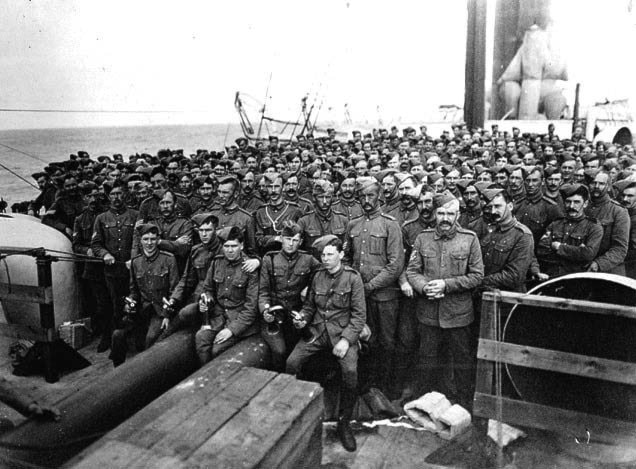Jim Cameron
And so they left. Bidding farewell to friends and family, the boys of the Strathcona Horse travelled to Ottawa to stay for one month while the regiment gathered to train and drill and learn the life of the soldier, sleeping in stables that commanding Officer Lt. Col. Sam Steele ensured were equipped with a palette and fresh straw for each of the men and even better accommodations for their beloved horses, hand-picked from across the country.
The regiment, in new uniforms and trademark Stetson hats, was honoured and admired by one and all. Throngs upon throngs presented flags and guidons and the cheers of a nation for the lads headed to fight the Boers of South Africa.
They learned to use their skills to ride and fight as a unit, but, in true Canadian fashion, generally failed to learn proper respect for authority and so also learned of the guardhouse and piquet duty and demerits, but only by way of warning, as Sam Steele himself was known to buck authority at times and these were his men, trained to fight his way.
Of the 20-odd recruits of Cranbrook, Adam Hall was the first to fall out, refused on medical grounds. The others, led by Captain Edmund Parker — their elected leader since enlistment — could barely contain their impatience in "getting in the thick of things," of "pulling [Boer leader] Oom Paul's whiskers," of "striking a blow for Queen and country."
Walter West, Alfred Jones, Henry Wiggins, John Kennedy, William O'Hearn, Isaac Foster, Charles and Frank Norton, Henry Melton, Walter Edwards, William Clarke and the others boarded the good ship "Monterey" in Halifax on Mar. 17, 1900, to sail for Cape Town, South Africa: 512 enlisted men, 28 officers, 599 horses and three machine guns. She was an able ship but rolled heavily in the rough March seas. The men recovered quickly; the horses suffered horribly. Two died the second day out, 11 the following day, seven the day after that.
Rocking incessantly in their stalls and brought down by "a type of pneumonia", the dying continued for the whole of the trip. Men watched in dismay as the bodies of their lifeless horses were cast into the sea.
The Strathcona Horse disembarked in Cape Town on April 11. It was, they discovered, a country of hot days and cold nights, of Boer prisoners who were "shot down like dogs" while trying to escape. A place where, according to William Clarke, "[as far as the war went] there was a great deal less excitement than in Cranbrook," where it was "puzzling that whites and blacks mix so freely." Where the Scottish regiments referred to the Canadians as "terriers" in deference of their fighting abilities. It was a bold new world for the men of the East Kootenay.
Private Simmell (of Vernon, B.C.) was the first casualty, brought down not by Boer bullets but, as so often the case in wartime, by a deadly infection.
Others, including Alex Watson of Cranbrook, were invalided home, while the remainder, some now transferred to other squadrons, trained on the Cape Town fields for yet another month while awaiting orders. They sailed for Durban on the east coast on May 24, to finally enter the fray in the surrounding countryside.
Edmund Parker, an experienced military man and the leader of the Cranbrook contingent, was not allowed to keep his rank once the regiment was officially formed. He re-enlisted as a private and was immediately signed on by Col. Steele as a Senior Sergeant who, in his diary, described Parker as "one of the finest shots in Canada, if not in the world." His shooting prowess was of little help in early August when he and 14 of his men rode into a settlement to accept what they thought was a Boer surrender but turned out to be a shooting gallery. Sgt. Parker was shot dead through the heart. He is buried in a well-kept grave in Watervaal, South Africa.
One month later Privates West, Jones and Wiggins fell on a hillside near Badfontein. Surrounded on all sides but unwilling to surrender, they fought with side by side their comrades to the last. They rest in a cemetery near Lydenburg, S.A., their gravestones adorned with maple leaves.
It was one of many battles for Company C of the Strathcona Horse during a war that (supposedly) came to an end in May 1902, following the Boer surrender. By then there were few Cranbrook soldiers in close quarters, split apart by transfers, illness, injuries and death. Most of the original Cranbrook contingent was discharged on March 8, 1901. Time spent in London included medals presented by the King. Some returned to the East Kootenay, others scattered elsewhere.
William O'Hearn and John Kennedy eventually returned home, working at various jobs and taking an active interest in civic affairs. William O'Hearn died in 1936, John Kennedy in 1945. The former Anglican Parish Hall on 2nd Street, now known as "Kennedy Hall," is so named in honour of four successive family generations who have seen military service. It is presently the home of the Lord Strathcona Army Cadet Corp.
Charles Spence, Cranbrook's last surviving Cranbrook Boer War veteran, did not serve with the Strathcona Horse. Enlisting prior to the formation of the regiment, he served one year in South Africa before returning home. Mr. Spence died on Jan. 29, 1967, age 87 years.
Note: There is much written of the Boer Wars and the role of the Strathcona Horse. The published letters of William Clarke and Walter Edwards provide a unique Cranbrook perspective while Sam Steele's War Diary, available online through the University of Alberta, is an invaluable resource.
